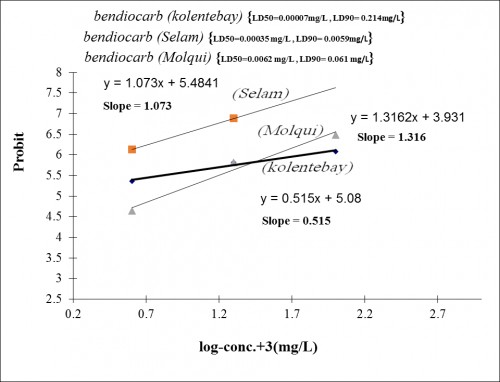Breeding habitats, identification and susceptibility of Anopheles arabiensis Patton (Diptera: Culicidae) larvae towards some insecticides in Gash Barka Zone, Eritrea
Author(s): Amanuel Mhretab Weldu Hagos, Nabil HH Bashir and Yousif OH Assad
Abstract: Gash Barka Zones (GBZ; western Eritrea) is one of the malaria endemic areas of the country. The present study aims to monitor and investigate the susceptibility of the larvae Anopheles arabiensis Patton (Diptera: Culicidae) to insecticides in three administrative localities in the GBZ, following WHO standard protocols. These localities were Kolentebay village (west), Selam suburb (Barentu town; center) and Molqui town (East). The study was conducted from Dec. 2017 –May 2018. The larvicide tested, at different concentrations, were temephos (the only larvicide used in the country), bendiocarb (used for indoor residual spraying, IRS) and permethrin (used for insecticide treated nets, ITNs). After mapping the breeding habitats in the three localities, larvae were collected, taken to the laboratory; the 3rd and 4th instars (L3 and L4) were separated from the others. A total of 1,350 larvae were used in the bioassay. Results were analyzed by SPSS Programs (V.23). For the populations collected from Kolentebay (K), Selam (S) and Molqui (M), the minimum and maximum ranges of LC50 and LC90 were for temephos from 0.0001-0.0103mg/L, and 0.005-0.91mg/L. For bendiocarb from 0.00007-0.0062mg/L, and 0.0059-0.061mg/L, respectively. For permethrin from 0.0002-0.0023mg/L and 0.00126-0.373mg/L), following the same order. The slopes of the log-dose probability lines (LD-P lines) for temephos were 0.743, 0(NA) and 0.658 for S, M and K larval populations, respectively. For bendiocarb were 1.073, 1.316 and 0.515, respectively for the localities, and for permethrin were 0.743, 0.579 and 0.77, following the same order. For knock-down Time (KDT), the highest mortality after 10min was 20%) for temephos, and bendiocarb, and 10% for permethrin. The maximum mortality after 1hr (i.e. 80%) was registered for temephos. It can be concluded that the population from M locality was more susceptible to temephos than the populations collected from S and K; the KdT of temephos for the population collected from K was higher than that of S and M in all tested concentrations.
 Fig.:
Fig.: Lethal concentrations of
A. arabiensis to Bendiocarb in Selam, Molqui and Kolentebay, GBZ, Eritrea.
How to cite this article:
Amanuel Mhretab Weldu Hagos, Nabil HH Bashir, Yousif OH Assad. Breeding habitats, identification and susceptibility of Anopheles arabiensis Patton (Diptera: Culicidae) larvae towards some insecticides in Gash Barka Zone, Eritrea. Int J Mosq Res 2019;6(5):28-36.



